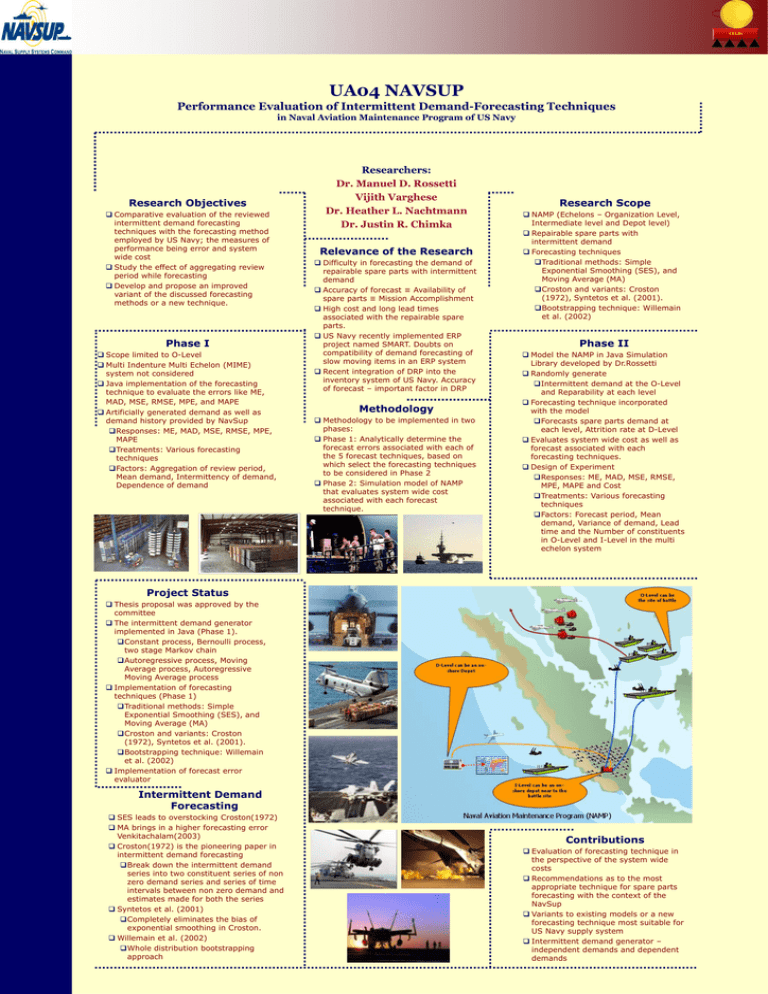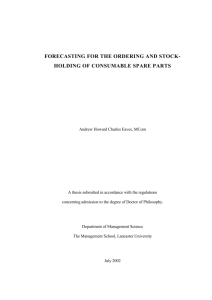Intermittent Demand Forecasting
advertisement

CELDi UA04 NAVSUP Performance Evaluation of Intermittent Demand-Forecasting Techniques in Naval Aviation Maintenance Program of US Navy Research Objectives Comparative evaluation of the reviewed intermittent demand forecasting techniques with the forecasting method employed by US Navy; the measures of performance being error and system wide cost Study the effect of aggregating review period while forecasting Develop and propose an improved variant of the discussed forecasting methods or a new technique. Phase I Scope limited to O-Level Multi Indenture Multi Echelon (MIME) system not considered Java implementation of the forecasting technique to evaluate the errors like ME, MAD, MSE, RMSE, MPE, and MAPE Artificially generated demand as well as demand history provided by NavSup Responses: ME, MAD, MSE, RMSE, MPE, MAPE Treatments: Various forecasting techniques Factors: Aggregation of review period, Mean demand, Intermittency of demand, Dependence of demand Researchers: Dr. Manuel D. Rossetti Vijith Varghese Dr. Heather L. Nachtmann Dr. Justin R. Chimka Relevance of the Research Difficulty in forecasting the demand of repairable spare parts with intermittent demand Accuracy of forecast ≡ Availability of spare parts ≡ Mission Accomplishment High cost and long lead times associated with the repairable spare parts. US Navy recently implemented ERP project named SMART. Doubts on compatibility of demand forecasting of slow moving items in an ERP system Recent integration of DRP into the inventory system of US Navy. Accuracy of forecast – important factor in DRP Methodology Methodology to be implemented in two phases: Phase 1: Analytically determine the forecast errors associated with each of the 5 forecast techniques, based on which select the forecasting techniques to be considered in Phase 2 Phase 2: Simulation model of NAMP that evaluates system wide cost associated with each forecast technique. Research Scope NAMP (Echelons – Organization Level, Intermediate level and Depot level) Repairable spare parts with intermittent demand Forecasting techniques Traditional methods: Simple Exponential Smoothing (SES), and Moving Average (MA) Croston and variants: Croston (1972), Syntetos et al. (2001). Bootstrapping technique: Willemain et al. (2002) Phase II Model the NAMP in Java Simulation Library developed by Dr.Rossetti Randomly generate Intermittent demand at the O-Level and Reparability at each level Forecasting technique incorporated with the model Forecasts spare parts demand at each level, Attrition rate at D-Level Evaluates system wide cost as well as forecast associated with each forecasting techniques. Design of Experiment Responses: ME, MAD, MSE, RMSE, MPE, MAPE and Cost Treatments: Various forecasting techniques Factors: Forecast period, Mean demand, Variance of demand, Lead time and the Number of constituents in O-Level and I-Level in the multi echelon system Project Status Thesis proposal was approved by the committee The intermittent demand generator implemented in Java (Phase 1). Constant process, Bernoulli process, two stage Markov chain Autoregressive process, Moving Average process, Autoregressive Moving Average process Implementation of forecasting techniques (Phase 1) Traditional methods: Simple Exponential Smoothing (SES), and Moving Average (MA) Croston and variants: Croston (1972), Syntetos et al. (2001). Bootstrapping technique: Willemain et al. (2002) Implementation of forecast error evaluator Intermittent Demand Forecasting SES leads to overstocking Croston(1972) MA brings in a higher forecasting error Venkitachalam(2003) Croston(1972) is the pioneering paper in intermittent demand forecasting Break down the intermittent demand series into two constituent series of non zero demand series and series of time intervals between non zero demand and estimates made for both the series Syntetos et al. (2001) Completely eliminates the bias of exponential smoothing in Croston. Willemain et al. (2002) Whole distribution bootstrapping approach Contributions Evaluation of forecasting technique in the perspective of the system wide costs Recommendations as to the most appropriate technique for spare parts forecasting with the context of the NavSup Variants to existing models or a new forecasting technique most suitable for US Navy supply system Intermittent demand generator – independent demands and dependent demands









